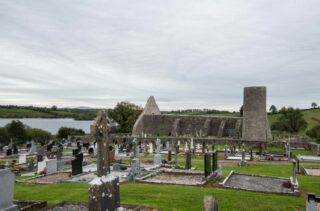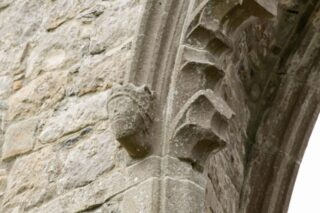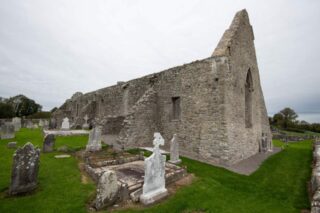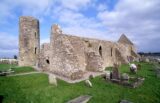
I joined the National Monuments Trim district in 2002 having previously worked in the Mallow district. The District Works Manager of the time, Tom Spears, brought me to see the church at Drumlane which is located on the shore of Garfinny Lough. The gable of the church ruin dominates the round tower and tranquil cemetery. On that first visit, we came to inspect the large eastern gable wall of the church which appeared to be gradually moving away from the two side walls, slipping slowly towards the lake. The presence of a series of large buttresses against the outside of the long side walls indicated a long history of structural instability. In an early image of the church, dating from 1792 in ‘The Antiquities of Ireland, Volume 2’ by Francis Grose, the church has a large steeply pitched roof which must have exerted a tremendous outward thrust on the long side walls. The buttresses were already in position in 1792 to provide additional stability and prevent the roof from causing the side walls to collapse. The outward pressure on the side walls was reduced when the roof perished but the gable wall was then fully exposed to the weather and began to deteriorate. We installed crack monitors and over the following years regularly inspected the gable wall for signs of active movement. In March 2014 Kieran Walsh of the OPW Structural Engineering Section, and I carried out a more detailed inspection from a hoist in order to assess the condition of the large vertical cracks at the junction of the east gable and the two long side walls of the medieval church. The inspection confirmed that the gable wall had moved and was in need of stabilisation works. The project was included in our 2014 business plan and works began in June of the same year.

The first part of the project was the protection of the grave slabs near the east gable, enclosing them in timber covers. We then erected a scaffold around the gable wall to facilitate the works. We were able to examine the masonry work at close quarters and do some preliminary opening up work. The cracks did not extend fully to ground level so there was no indication of a structural problem with the foundations. The cracks widened as they moved further up the wall, confirming that the gable of the church was not strongly bonded to the two long flanking walls and had moved away from them. Without the protection of a roof, walls will develop problems due to the constant movement of water through the structure. The mortar bond between the stones is gradually washed out until there is little structural integrity left in the masonry.

The OPW stonemasons carried out the consolidation works to the gable, working during the summer months when the days were long and the temperatures suitable for lime mortars. We rebuilt large sections of the walls, particularly around the areas that had moved out of position. The rebuilt masonry was strengthened with stainless steel ties to ensure a good joint with the existing walls and the entire gable was repointed. As the works proceeded upwards, a lime based grout was introduced into the walls to ensure that all the internal voids were filled and stable. Finally, the wall tops were flaunched to ensure that the rainwater ran smoothly off the walltops. Works were completed in April 2017 and the enclosing scaffolding cover was left in place for an additional year to assist with the curing of the lime mortars and grout.

We are now confident that the gable wall is stable and the future of this important ecclesiastical assembly is secure. OPW Trim National Monuments staff will continue to monitoring the condition of the buildings and maintain the church and round tower. We will assist the Department of Culture, Heritage and the Gaeltacht in their role of conserving Ireland’s unique heritage for the benefit of present and future generations. The works on site were supervised by Tommy Halton, District Works Manager and carried out by Michael Dempsey, Willie Foley, Eamon Gilsenan, Ger Doherty, Brian Murray, Eamonn Howley, Brendan Hussey, Willie Hussey, Derek Caroll, Thomas Donnelly, Mark Leavy and Ger Brennan.
Ana Dolan worked as a Senior Conservation Architect with the Office of Public Works until her retirement in 2020.

